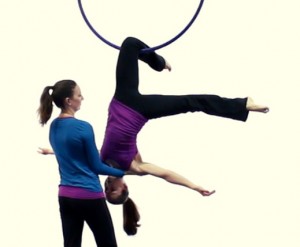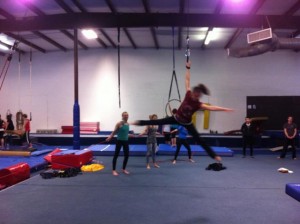When Julianna and I started brainstorming for the Aerial Hoop Manual Volume 1, we realized that there is a distinct difference between correct technique and choreographic choice. I am a fan of saying, “Nothing is wrong [as far as body positions in space] as long as it is done on purpose and with full body awareness.” Julianna is a big fan of saying, “But don’t forget to take your vitamins.”

Because of my background in dance, I am very experimental when it comes to aerial movement. I appreciate what the Aerial Dance Festival in Boulder, CO has done for the aerial dance world. The idea is to treat your apparatus like a contact improvisation partner and go for it. There is about as much as modern dance in terms of proper technique and relatively little in terms of set moves that get progressively more difficult. Because of my love of modern dance and all pioneers in the field, I love keeping the idea that all positions of the body are okay as long as you are aware of what your body is doing. Every shape can have an expressive purpose, and in this framework, I play. I do very little conditioning or what’s “proper.” The whole reason I have enjoyed writing the books is because it has forced to me to sit down and look at moves in ways in which I typically ignore them.
Our conversation started when we discussing the single knee hang on hoop. I, of course, just wanted to hang out. Up I went on the hoop to just hang ten. Julianna, as sternly as my ballet teacher told me I had terrible feet, said that I was turning my hips out and needed to work on squaring them.
Me: “I don’t need to square my hips. I like working in turn out.”
Julianna: “But you need your vitamins! You can turn out once you have learned how to work in parallel. Working in parallel will train your muscles how to properly engage so that you can go into turn out from there.”
Me: “I am awesome and can do anything in aerial. Let me try this exercise.” Me 5 seconds later: “That’s freakin’ hard! I do need to train this area! My hamstrings are weak! Julianna, thank you for making me take my vitamins!”
Okay, so the conversation didn’t really go like that, but you get the idea. I still hold fast to the idea that anything is permissible, but not everything is a healthy place from which to build a foundation. It is important in training and teaching that you set yourself up with proper technique and form. Train the muscles that are required to support your weight so that when you do choose to disengage and go all over the place, you can do so smartly and by choice, not because of muscle weakness.
There are two important lessons here:
1) Take your aerial vitamins. Example: Train the single knee hang in parallel before working in turn out or disengaging.
2) Don’t be afraid of the things that teachers say are wrong for form. Understand that they are only wrong for the vitamin version. Example: It is perfectly fine to release and go crazy in your knee hang, but if you have skipped your vitamins, you risk working on a weak hamstring, and your body may lack the ability to properly protect you from injury because it hasn’t learned the proper engagement.
For example, holding a hoop with thumbs wrapped is an important technique to teaching a beginner how to hold the hoop. This gives the grip more support and protects the student from precarious wraps. In fact, telling a student anything about their grip is a good thing because they need to get their body awareness to that part of their body and having something to focus on gets the right neurons firing to that part of the body. But, I have met many professional aerialists who haven’t given a second thought to performing moves without their thumbs wrapped. Does this mean we should throw out the old “thumbs wrapped method?” NO! It just means that professional aerialists get to make choreographic choices that may go against everything a beginning student has learned. That’s okay. It’s important to teach beginners so that they know the difference and understand that one day they get to make their own choreographic decisions as well.
Another example is engaged shoulders versus disengaged shoulders. Yes Yes Yes, it is important to have the shoulders engaged during technique training. Are there times when a professional aerialist may make a choreographic choice to disengage the shoulders during a static or dynamic movement? Yes! And it’s perfectly okay because they have all the body awareness, technique and strength required to execute it safely.
These issues can sometimes get a little uncomfortable to some. It is like the ballet dancer finding themselves in a modern class where the teacher is telling them to work in parallel instead of turn out and let go of their centers. It goes against everything they were ever taught! You will find some teachers have very strict standards about what is “right” and “wrong” as far as technique goes. The good thing is that they are teaching great form and keeping beginning students free of injuries. The down-side is that sometimes, they cling so hard to policing form that they do not allow the dance to happen.
For beginning aerial students, I say: Do not neglect your vitamins! You may want to jump straight into choreographic choices because they are more fun and feel better on your body, but you cannot neglect your vitamins! These come first.
For professional teachers, I say: Do not be overly concerned that another teacher is teaching something totally different from the way that you teach it. Maybe it is not always the vitamin strength the students needs, but more often than not, it’s not wrong. It’s just a choreographic choice. Have the wisdom to know the difference.





